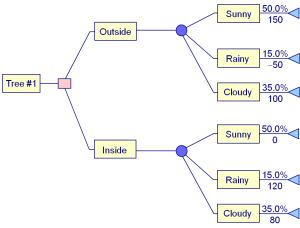Effective decision analysis requires the business analyst to understand several aspects of the decision in order to effectively structure the decision problem and process. They need to be aware of any relevant values, goals and objectives and should clearly understand the nature of the decision that must be made. It is essential to identify the areas of uncertainty affecting the decision and the consequences of each possible decision. Uncertainty often results in calculating the expected value of outcomes versus knowing the actual values by computing the percentage chance of each outcome taking place and multiplying the numeric value for the outcome by that percentage.
Decisions and their resulting outcomes can be either financial or non-financial in nature. In either case, the business analyst uses financial models to both estimate and value a particular decision in financial terms. This is done to provide a method for comparing the outcomes in a comparable fashion. Common financial valuation techniques that the business analyst (and the project manager!) might use include:
- Discounted Cash Flow: Calculate the future value of money using specific data such as an interest rate
- Net Present Value (NPV): Convert the future value of costs and benefits to today’s value
- Internal Rate of Return (IRR): Calculate the interest rate (or discount rate) when NPV = 0
- Average Rate of Return: Estimate the rate of return on an investment across a specified time period
- Payback Period: Determine the amount of time it takes for an investment to pay for itself without considering the time value of money
- Cost-Benefit Analysis (CBA): Use a ratio to quantify the costs and benefits for a proposed solution where benefits typically equal revenue
One of the simplest methods used in trade-off decision-making is performed using a decision tree. This allows the business analyst to determine the Expected Monetary Value (EMV) to assist them in weighing decision alternatives and evaluate the monetary impact of the potential decisions. Starting at the far right of the tree on the smallest branches, we multiply the probability assigned to that outcome by the expected monetary impact for each branch. EMV is also called actuarial value.
The tree example you see here is a structured decision-making approach for whether or not a street vendor should set up a stand inside or outside based upon the weather predictions for a particular day.
Imagine that we are dealing with the weather prediction: “There’s a 50% chance of sun today, 35% chance of some clouds and a 15% chance of rain.” We need to use our experience to assign a value to what money we earn inside or outside come sun, clouds or rain. Then working from right to left, we can calculate the EMV (outside) = $102.50 and the EMV (inside) = $46.00 for each node (the small circle). Based upon the probabilities and the values we assigned to the outcomes, the best decision would be to put the vendor stand outside today (and hope that it doesn’t rain!)
Well, that is our closer look at one of the 16 recommended techniques used by business analysts, decision analysis. Holler if there is another technique you would like to review. Remember, all of the techniques found in the BABOK® Guide may appear in your exam questions, so spend some time with Chapter 9 and make sure you know each and every technique!
Susan

No comments:
Post a Comment